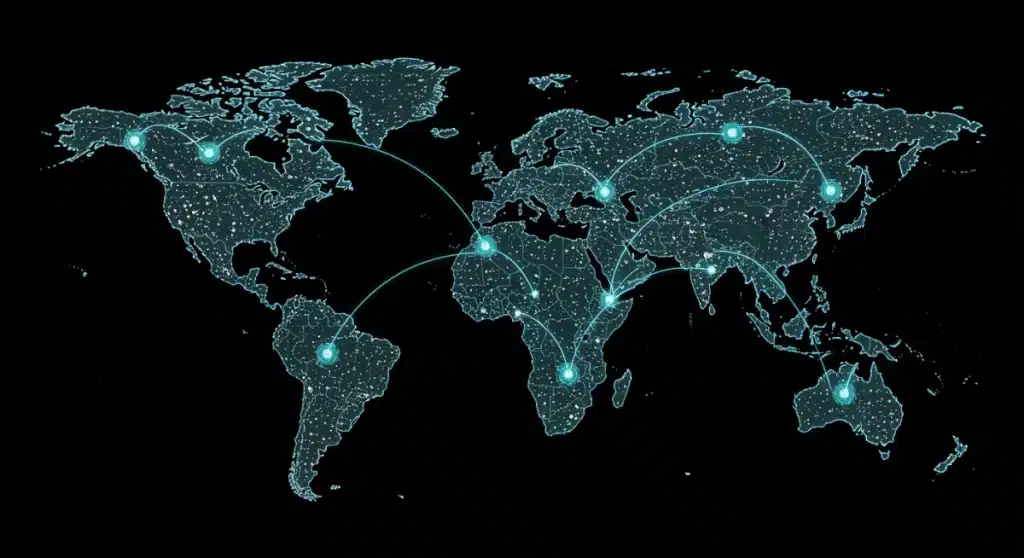AI Geopolitics: What U.S. Citizens Need to Know Now

The rapidly evolving AI geopolitics US landscape presents significant challenges and opportunities, influencing national security, economic competition, and technological sovereignty for American citizens in the coming year.
In an increasingly interconnected world, the rapid advancement of artificial intelligence (AI) has emerged as a pivotal force reshaping global power dynamics. For U.S. citizens, understanding The Geopolitical Landscape of AI Development: What U.S. Citizens Need to Know for the Next 12 Months is not merely an academic exercise, but a critical imperative. This isn’t just about the latest gadgets or software; it’s about national security, economic stability, and the very fabric of our society.
The Global AI Arms Race: Key Players and Their Strategies
The development of artificial intelligence has ignited a global competition, often dubbed an ‘AI arms race,’ among major powers. This race is not just about who develops the most advanced algorithms, but who controls the data, talent, and infrastructure necessary to sustain AI innovation. For U.S. citizens, recognizing the primary actors and their strategic approaches is crucial to understanding potential shifts in global influence.
The United States, China, and the European Union stand as the foremost contenders in this technological contest. Each approaches AI development with distinct philosophies, resource allocations, and geopolitical objectives. Their strategies often reflect their unique political systems and economic priorities.
United States: Innovation and Private Sector Leadership
The U.S. strategy for AI largely relies on its robust private sector and academic institutions. Silicon Valley remains a global hub for AI research and development, attracting top talent and capital. The government’s role often involves funding basic research, setting regulatory frameworks, and fostering public-private partnerships.
- Venture Capital Investment: Significant private funding drives rapid innovation.
- Research Universities: Leading institutions like Stanford, MIT, and Carnegie Mellon are at the forefront of AI breakthroughs.
- Defense Applications: The Pentagon is increasingly integrating AI into military operations and intelligence.
China: State-Led Development and Data Dominance
China’s approach to AI is characterized by strong state backing and a national strategy aimed at becoming the world leader in AI by 2030. This includes massive state investment, data collection on an unprecedented scale, and a focus on integrating AI into all aspects of its economy and society.
- National AI Plan: Centralized directives guide research, development, and deployment.
- Data Accumulation: Vast population data fuels AI training and development.
- Surveillance and Social Control: AI is extensively used for monitoring and governance within China.
European Union: Regulation, Ethics, and Human-Centric AI
The EU prioritizes ethical considerations and robust regulatory frameworks in its AI strategy. While perhaps not matching the U.S. or China in sheer investment, the EU aims to set global standards for responsible AI development, emphasizing human rights and privacy.
This competition extends beyond economic benefits; it touches on national security, ethical guidelines, and the future of international relations. The U.S. must navigate this complex environment, balancing innovation with responsible governance.
In conclusion, the global AI arms race is defined by the distinct strategies of the U.S., China, and the EU. Understanding these differing approaches is fundamental for U.S. citizens to grasp the ongoing geopolitical shifts and their potential impact on American interests and values.
Economic Implications: Jobs, Industries, and Global Trade
The rise of AI is poised to dramatically reshape global economies, impacting everything from labor markets and industrial productivity to international trade balances. For U.S. citizens, these economic implications are not abstract; they will manifest in job availability, consumer prices, and the competitiveness of American industries. The next 12 months will likely see accelerating trends in AI adoption across various sectors.
Automation driven by AI is a primary concern, with many wondering about the future of work. While some jobs may be displaced, new ones will undoubtedly emerge, demanding new skill sets and educational pathways. This transformation requires proactive strategies from both government and the private sector to ensure a smooth transition for the workforce.
Impact on Labor Markets
AI will lead to significant shifts in employment. Repetitive tasks are most susceptible to automation, while roles requiring creativity, critical thinking, and complex problem-solving may see increased demand. This necessitates a focus on reskilling and upskilling programs.
- Automation of Routine Tasks: AI systems can perform data entry, customer service, and manufacturing tasks more efficiently.
- New Job Creation: Demand for AI developers, data scientists, and ethical AI specialists will grow.
- Skill Gaps: A mismatch between existing workforce skills and new AI-driven job requirements.
Industrial Transformation and Productivity Gains
Industries across the board are integrating AI to boost efficiency, reduce costs, and innovate. From healthcare to finance, manufacturing to agriculture, AI offers unprecedented opportunities for growth and optimization. This can enhance the global competitiveness of U.S. companies.
However, this transformation also raises questions about market concentration, as large tech companies with significant AI capabilities may gain an even greater advantage. Ensuring fair competition and preventing monopolies will be crucial for a healthy economic landscape.
Global Trade and Supply Chains
AI can optimize supply chains, predict demand, and enhance logistics, leading to more resilient and efficient global trade. However, countries that lead in AI development may gain a significant competitive edge in international markets, potentially altering existing trade relationships and power dynamics.

The economic implications of AI for U.S. citizens are far-reaching. While opportunities for growth and increased productivity are immense, challenges related to job displacement, skill development, and maintaining market fairness must be addressed. Remaining adaptable and investing in education will be key to thriving in this AI-driven economy.
National Security and Defense: The AI Battlefield
Artificial intelligence is rapidly transforming the landscape of national security and defense, introducing new dimensions to warfare, intelligence gathering, and cybersecurity. For U.S. citizens, understanding the Pentagon’s engagement with AI and the associated risks is paramount, as these developments directly impact global stability and America’s defensive capabilities. The next 12 months will likely see further integration of AI into military systems and strategic planning.
The potential for AI to enhance military capabilities is extensive, ranging from autonomous weapons systems to advanced surveillance and predictive analytics. However, this also brings complex ethical dilemmas and the risk of an AI-driven arms race, prompting international discussions on regulation and control.
Autonomous Weapons Systems
The development of AI-powered autonomous weapons, often referred to as ‘killer robots,’ is a contentious issue. While proponents argue they could reduce human casualties and increase precision, critics raise concerns about accountability, ethical decision-making, and the potential for unintended escalation.
- Lethal Autonomy: Systems capable of selecting and engaging targets without human intervention.
- Ethical Debates: Questions about moral responsibility and the ‘human in the loop’ principle.
- International Treaties: Calls for global regulation or bans on fully autonomous weapons.
Intelligence and Cyber Warfare
AI significantly enhances intelligence analysis, enabling faster processing of vast amounts of data to identify patterns and predict threats. In cyber warfare, AI can be used for both offensive and defensive operations, detecting anomalies, automating responses, and developing sophisticated attacks.
The U.S. military is investing heavily in AI for these applications, aiming to maintain a technological edge. However, this also means facing more sophisticated cyber threats from state and non-state actors who are also leveraging AI.
Geopolitical Stability and Escalation Risks
The integration of AI into defense systems could alter the delicate balance of power, potentially leading to new forms of strategic instability. The speed at which AI systems can operate might compress decision-making timelines, increasing the risk of rapid escalation in conflicts.
Furthermore, the opaque nature of some AI algorithms could make it difficult to understand an adversary’s intentions or even one’s own system’s behavior, adding another layer of complexity to international relations.
Ultimately, the AI battlefield presents both opportunities for enhanced security and significant risks. U.S. citizens should be aware of the ongoing debates and decisions regarding AI’s role in defense, as these will shape the future of international conflict and peace.
Regulatory Challenges and Ethical Frameworks
As AI technologies rapidly advance, the challenge of establishing effective regulatory frameworks and ethical guidelines becomes increasingly urgent. For U.S. citizens, these discussions directly impact privacy rights, the fairness of algorithms, and the accountability of AI systems. The next 12 months are crucial for shaping domestic and international approaches to AI governance, with potential implications for innovation and societal trust.
Governments worldwide are grappling with how to regulate AI without stifling innovation, while also protecting citizens from potential harms. This involves balancing economic competitiveness with fundamental human values, a task that is proving to be immensely complex.
The Need for Comprehensive Regulation
Current legal frameworks often lag behind technological advancements, leaving gaps in how AI is governed. There is a growing consensus on the need for new laws and policies specifically designed to address AI’s unique characteristics and challenges.
- Data Privacy: Protecting personal information used to train and operate AI systems.
- Algorithmic Bias: Ensuring AI systems do not perpetuate or amplify existing societal biases.
- Transparency and Explainability: Making AI decisions understandable and auditable.
Ethical AI Principles
Many organizations and governments are developing ethical AI principles to guide responsible development and deployment. These principles often emphasize human oversight, fairness, safety, and accountability. However, translating these broad principles into actionable policies remains a significant hurdle.
The European Union has taken a leading role with its proposed AI Act, aiming to categorize AI systems by risk level and impose stringent requirements. The U.S. has adopted a more sector-specific and voluntary approach, though calls for a national strategy are growing.
International Cooperation and Standards
Given AI’s global nature, international cooperation is essential for effective regulation. Harmonizing standards and sharing best practices can prevent a fragmented regulatory landscape, which could hinder cross-border innovation and create loopholes for malicious actors.
Discussions in forums like the G7 and the UN are attempting to forge common ground on AI governance, addressing issues like autonomous weapons, disinformation, and the responsible use of AI in critical infrastructure.
In summary, the regulatory challenges and ethical frameworks surrounding AI are complex and multifaceted. U.S. citizens should pay close attention to policy debates, as decisions made in the coming year will profoundly influence the trustworthiness and societal impact of AI technologies.
Technological Sovereignty and Supply Chain Vulnerabilities
Technological sovereignty, particularly concerning AI, has become a critical concern for nations worldwide. For U.S. citizens, this concept relates directly to the nation’s ability to control its technological destiny, secure its data, and protect against supply chain vulnerabilities. The next 12 months will highlight ongoing efforts to strengthen American technological independence and mitigate risks associated with global AI supply chains.
The reliance on foreign components, data centers, or software can create significant national security risks, making a country vulnerable to espionage, sabotage, or economic coercion. Ensuring that critical AI infrastructure and capabilities reside within national borders or trusted alliances is a strategic imperative.
Securing the AI Supply Chain
The AI supply chain is incredibly complex, involving everything from semiconductor manufacturing to data storage and software development. Disruptions or malicious insertions at any point can have cascading effects, impacting national security and economic stability.
- Semiconductor Dependence: Reliance on a few key manufacturers for advanced chips, primarily in Asia.
- Data Center Security: Protecting critical data infrastructure from cyberattacks and foreign interference.
- Software Integrity: Ensuring the trustworthiness and security of AI algorithms and platforms.
Promoting Domestic AI Capabilities
To reduce reliance on foreign technologies, the U.S. is investing in domestic research, development, and manufacturing of AI components and systems. This includes initiatives to boost semiconductor production within the U.S. and foster home-grown AI talent.
The CHIPS and Science Act is a prime example of legislation aimed at revitalizing domestic semiconductor manufacturing. These efforts are crucial for building resilience and maintaining a competitive edge in the global AI landscape.
International Alliances and Trusted Partnerships
While striving for domestic independence, the U.S. also recognizes the importance of collaborating with trusted allies. Forming strategic partnerships with countries that share similar values and security concerns can help diversify supply chains and collectively address technological vulnerabilities.

In essence, technological sovereignty and addressing supply chain vulnerabilities are vital for safeguarding U.S. interests in the AI era. Citizens should be aware of the government’s efforts to secure critical technological assets and foster domestic innovation to ensure national resilience.
The Impact of AI on Democracy and Governance
The widespread adoption of AI technologies carries profound implications for democratic processes and forms of governance, both domestically and internationally. For U.S. citizens, understanding how AI can influence elections, public discourse, and government transparency is essential. The next 12 months will likely bring increased scrutiny on AI’s role in political landscapes and the challenges it poses to democratic institutions.
AI’s ability to process vast amounts of information, generate persuasive content, and automate decision-making can be a double-edged sword. While it offers tools for efficiency and better public services, it also presents risks of manipulation, surveillance, and the erosion of trust in democratic systems.
Disinformation and Foreign Interference
AI-powered tools, particularly generative AI, can be used to create highly realistic fake content, including deepfakes and synthetic media. This poses a significant threat to information integrity, making it harder for citizens to distinguish truth from falsehoods, especially during election cycles.
- Deepfakes: AI-generated videos or audio that manipulate individuals’ appearances or voices.
- Automated Propaganda: AI bots and algorithms spreading misinformation at scale.
- Electoral Integrity: Challenges to the fairness and credibility of democratic elections.
AI in Government Decision-Making
Governments are increasingly exploring AI for various functions, from predicting crime patterns to managing public resources. While this can lead to more efficient governance, it also raises concerns about transparency, accountability, and potential biases embedded in algorithms.
Citizens have a right to understand how AI systems are used in public services and to ensure that these systems are fair, unbiased, and subject to appropriate oversight. The lack of transparency can erode public trust and undermine democratic principles.
Surveillance and Civil Liberties
The advanced surveillance capabilities offered by AI, such as facial recognition and predictive policing, create tension with civil liberties and privacy rights. Balancing national security needs with individual freedoms is a critical challenge for democratic societies.
The potential for AI to enable mass surveillance by authoritarian regimes also highlights the global implications for human rights and the spread of democratic values. The U.S. must navigate these issues carefully, setting an example for responsible AI use.
Ultimately, AI’s impact on democracy and governance is a complex issue requiring vigilant oversight and active citizen engagement. Protecting democratic institutions from AI-driven threats while harnessing its potential for public good will be a defining challenge for U.S. citizens in the coming year.
Future Outlook: Preparedness and Adaptation for U.S. Citizens
Looking ahead, the next 12 months will be a period of intensified adaptation and strategic adjustments in response to the accelerating pace of AI development. For U.S. citizens, preparedness involves understanding the evolving landscape and actively engaging with the opportunities and challenges AI presents. This requires a multi-faceted approach, encompassing education, policy advocacy, and personal readiness.
The future outlook for AI is not a fixed destination but a dynamic process shaped by choices made today. The U.S. has a critical role to play in steering this future towards one that is beneficial, equitable, and secure for its citizens and the global community.
Education and Workforce Development
Investing in education and continuous learning is paramount. Citizens will need to adapt their skill sets to thrive in an AI-driven economy. This involves promoting STEM education, digital literacy, and critical thinking from an early age, as well as providing reskilling opportunities for adult workers.
- Digital Literacy: Understanding AI’s basic functions and implications.
- STEM Education: Fostering skills in science, technology, engineering, and mathematics.
- Lifelong Learning: Adapting to new technologies through continuous education and training programs.
Policy Advocacy and Citizen Engagement
U.S. citizens have a vital role in shaping AI policy. Engaging with elected officials, advocating for ethical AI frameworks, and demanding transparency in AI governance are crucial steps. Informed public discourse can help ensure that AI development aligns with democratic values and societal well-being.
This includes advocating for policies that address algorithmic bias, protect data privacy, and promote fair competition in AI markets. Active participation in these discussions ensures that citizen voices are heard in the formation of future regulations.
Personal Adaptation and Critical Thinking
On a personal level, citizens should cultivate critical thinking skills to navigate an information environment increasingly influenced by AI. Being able to discern credible information from AI-generated misinformation is a fundamental skill for the future.
Moreover, understanding how AI impacts daily life, from personalized recommendations to automated services, allows individuals to make informed choices about their data and interactions with technology. Embracing a mindset of continuous learning and adaptability will be key.
In conclusion, the future outlook for AI demands proactive preparedness and adaptation from U.S. citizens. By investing in education, engaging in policy advocacy, and fostering critical thinking, Americans can help shape an AI future that is both innovative and aligned with their values.
| Key Aspect | Brief Description |
|---|---|
| Global AI Race | Competition between U.S., China, and EU for AI dominance, impacting innovation and global influence. |
| Economic Shifts | AI’s influence on job markets, industrial productivity, and international trade dynamics. |
| National Security | AI’s role in defense, intelligence, cyber warfare, and the implications for global stability. |
| Regulatory Challenges | The urgent need for ethical frameworks and comprehensive laws to govern AI development. |
Frequently Asked Questions About AI Geopolitics
The primary concern is how the global competition in AI development impacts national security, economic stability, and democratic values. Citizens need to understand these shifts to prepare for their effects on jobs, privacy, and international relations.
In the short term, AI is accelerating automation, potentially displacing some jobs while creating new ones requiring advanced skills. It’s also boosting productivity in various sectors and influencing global trade dynamics, affecting competitiveness.
AI has significant national security implications, including the development of autonomous weapons, enhanced intelligence gathering, and sophisticated cyber warfare capabilities. It also raises concerns about strategic stability and ethical use in defense.
AI regulation is vital to protect citizens’ data privacy, prevent algorithmic bias, and ensure accountability in AI systems. It also aims to foster ethical AI development that aligns with human rights and democratic principles.
Citizens can prepare by focusing on continuous education and skill development, engaging in policy advocacy to shape AI governance, and cultivating critical thinking to navigate AI-influenced information environments and daily life.
Conclusion
The geopolitical landscape of AI development is undeniably complex and fast-moving, presenting both unprecedented opportunities and significant challenges for the United States and its citizens. Over the next 12 months, the ongoing global competition, economic transformations, national security considerations, and the urgent need for robust regulatory frameworks will continue to shape the American experience. By staying informed, advocating for responsible policies, and embracing continuous learning, U.S. citizens can play an active role in navigating this critical technological frontier and ensuring that AI serves to enhance, rather than diminish, their future and the nation’s standing in the world.





